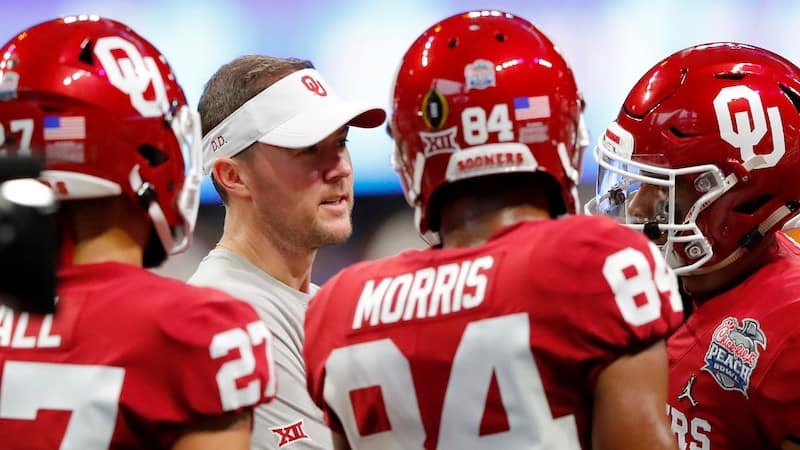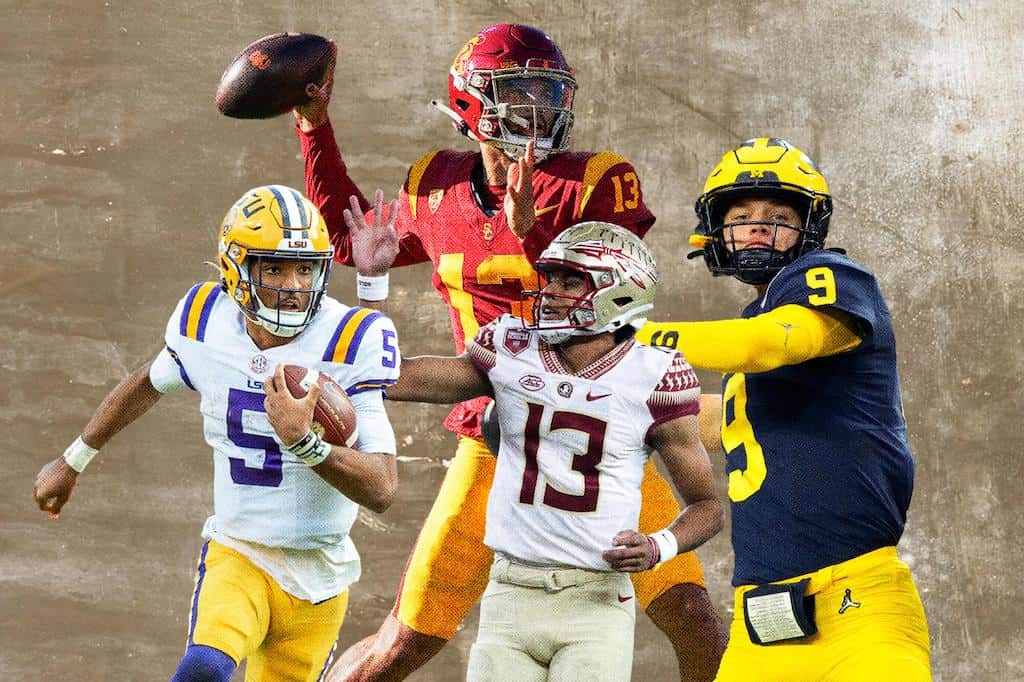It’s every bettor’s dream. They wake up on a Saturday, watch football all day, and then cash in on their winning college football bets. There just isn’t anything more exciting on a Saturday in the fall. Sports Hub is here with you and for you all season long. We arm you with everything you need to take advantage of your 2023 college football bets.
Our Sports Hub experts are off to a great start this season. Our computer picks continue to produce wins at a 59 to 60 percent clip. Every week of the season, we prepare you for what is to come with our weekly NCAA football picks pages. These are dedicated pages that provide breakdowns of the top games each week.
There is a section full of expert handicapper picks as well as rundown of our experts best picks in different categories. Here, you will find the week’s best ATS pick, totals pick, etc. It’s just one of the many ways Sports Hub helps you win more college football bets compared to other college football betting sites.
Key Stats for Covering the CFB Spread
Finding the Holy Grail of winning more college football bets, or an analytical method to solve the conundrum of predicting which teams would cover the spread, has long been on the minds of college sports bettors.
There were the Five Factors, which were readily available nowadays and from a variety of sources. Could these categories predict which team would cover the point spread? If so, how does one go about using them to determine if, indeed, one team is more likely to cover than its opponent?
A number of metrics from previous seasons were used, including Quality Drives and Havoc numbers. Other more common stats like field position, red zone drives, and even turnovers were ultimately discarded as there were better key stats that could be used.
Eventually, three statistical categories emerged as those that can help bettors successfully predict teams covering the point spread. The following categories can help you win more NCAA football bets against the spread:
- Explosiveness
- Success Rate
- Finishing Drives
Let’s examine each factor and how they can affect college football bets.
How Explosiveness Affects College Football Bets
First off, you have to understand how to measure or quantify what we call explosiveness. As an NCAA football fan, we can probably identify an explosive play. It’s a long pass or running play that offenses love to have and defenses work to prevent. Explosive plays can be measured a few different ways.
Bettors can use Isolated Points Per Play (IsoPPP) or Expected Points Added (EPA) to measure how explosive a team is on offense or defense. It’s not so much how these numbers are reached. It’s what they measure.
It should be pretty simple to realize that the more an offense scores per play, the more explosive it is. The same with EPA. Now, just because a team is explosive doesn’t necessarily mean that it will win games and cover point spreads. Consider the following as evidence.
A high Expected Points Added ranking translates to just a 51.8% cover rate on both sides of the ball. That’s nothing earth-shattering and is still a ways off from our break-even point. The bottom line is that teams that produce a lot of explosive plays don’t necessarily win more games. Likewise, defenses that prevent big plays don’t always win over cover point spreads. So, how do we win more college football bets against the spread?
Success Rate in College Football
Again, we should understand what Success Rate is before we use it to help us with our college football bets. Success Rate is simply the number of successful plays divided by the number of total plays. The key here is what makes a successful play. That depends upon what down it is.

A first down play is successful if it achieves 50 percent of the yards needed for a first down. On second down, a play needs to gain 70 percent of the yards needed for a first down. On third and fourth down, a play must gain 100 percent of the yards needed for a first down.
Translating this, you should be able to see that a gain of five yards on first down is much more important than gaining five yards on third-down-and-9. Success Rate, both on offense and defense, does translate into more ATS wins and more wins with your college football bets.
Success Rate and College Football Bets ATS
The top 25 offenses over the last five seasons in Success Rate have covered the spread 53.9 percent of the time. The top 25 defenses in Success Rate have covered 54.6 percent of the time. The numbers are even greater if you look at the bottom of the Success Rate standings.
The bottom 10 percent of teams in Defensive Success Rate since 2018 have failed to cover the spread nearly 60 percent of the time (59.6%). In analyzing Success Rate numbers, the big thing is that if a team cannot produce roughly 42.5 percent success on offense or 41.6 percent on defense, they are going to have trouble covering a spread. Those are numbers that will definitely help you win more college football bets.
Finishing Drives Is Related to Winning College Football Bets
The ultimate tool in identifying NCAA football teams to cover the spread may very well be the Finishing Drives metric. Offenses that finish drives and defenses that prevent them are much more likely to cover point spreads. First, we need to understand how finishing drives is calculated. Then, we can use the information to make college football bets.
The Finishing Drives metric is measured as points per drive inside an opponent’s 40-yard line. Once you make it inside the opposing 40, the ability to score points then is a determining factor in covering the point spread. Teams that reach their opponent’s 40-yard line and then score are more likely to achieve ATS wins. Bettors then end up winning more college football bets.
In the grand scheme of things, the top 25 percent of offenses in Finishing Drives since 2018 have covered at a 55.4 percent clip. On the other side, defenses that prevent scores when opponents get inside their 40 cover at a rate of 57.1 percent.
College Football Betting Using Key Metrics
Just like with Success Rate, we can dial it in even deeper on the teams that do not convert on offense inside an opponent’s 40-yard line. The bottom 10 percent of CFB teams in Finishing Drives over the last five seasons fail to cover over 60 percent of the time (60.6%). It’s still early in the 2023 NCAA football season, but using these three tools – Explosive Plays, Success Rate, and Finishing Drives – can help you win more college football bets against the spread.
Looking at the 2023 season, Washington, Oregon, and USC are three teams that will return a sizable amount of offensive talent and have a strong scoring history in 2023. Texas A&M and South Alabama are among the defensive teams that have the most experience after posting exceptional Finishing Drives numbers in 2022. It may be worth examining NCAA football bets involving these teams this season.
Key Numbers for NCAAF Totals
When placing college football bets, getting the best number is crucial. Similar to stocks, knowing when to enter a hot market can help you get the best closing line. Key numbers in college football are one of the most frequently discussed topics among bettors. Knowing how to read college football odds helps too.
When betting sides – either moneyline or ATS – the key numbers are similar to the NFL. Those numbers are 3 and 7. That’s because of how football is scored. Field goals are worth three points and a touchdown with a PAT (kicked point after touchdown) is worth seven. More college football games end with scoring margins of 3 and 7 than any other number.
Sports Hub expert Gino Russo is a perfect example of a handicapper who understands key numbers. Through the beginning of the 2023 CFB season, Gino is cashing 81 percent of his bets. Our experts use key numbers. You should too.
Nah mad dog talking bout he gonna take some gummies & get sauced on Saturday while watching college football 💀💀 pic.twitter.com/1pILS3hrUk
— Shannonnn sharpes Burner (PARODY Account) (@shannonsharpeee) September 20, 2023
NCAA Football Lines Differ from NFL Lines
When it comes to totals, CFB numbers differ from those in the NFL. With the evolution of the Air Raid offense and up-tempo spread offense schemes, the college game is much more higher scoring. Teams like head coach Lincoln Riley’s USC Trojans and Josh Heupel’s Tennessee operate at a high speed and take multiple shots downfield. Defenses aren’t as good as NFL defenses either. That makes NCAA football a higher-scoring game.
Since 2018, the most common college football total is 55. In the NFL, the number is 41. You can see the difference as you contemplate college football bets on totals. Over those last five seasons, a total of 55 has occurred in almost 4 percent (3.98) of all games.
Totals of 51, 45, 59, and 48 round out the top-5. The top-5 totals account for nearly 15 percent of all NCAA football games. They can help you make your best bets on totals. That’s powerful information when making college football bets in the totals betting markets.
How to Bet New Clock Rules and OC Changes
Conference realignment was a big topic leading into the 2023 season. The Big 12 welcomed four new programs this season. The conference will welcome a few more next year, as will the Big Ten. One thing that kind of flew under the radar was a rule change that affects the game clock. It will, in turn, affect your college football bets on totals.
Since 1968, the game clock has stopped when a team makes a first down. The chains are reset, and the referee signals when the game clock will start after the first down. That will change in 2023. The clock will run after a first down throughout the entire game except for the last two minutes of each half.
Many coaches have commented on the rule change, talking about how the new clock rule will eliminate roughly three to five minutes per game. A college football game typically has 38 or so first downs, according to historical data. For every first down, setting the ball takes five to eight seconds of the game clock. amounting to an average of 3.2 to 5.1 minutes of time burned.
With less time, it only makes sense that teams will score less. It will be interesting to see how the rule change influences online betting and college football bets on totals, prop bets, and more throughout the 2023 season.
Coaching Changes Influence College Football Bets
At Wisconsin, where Phil Longo has taken over play-calling duties, there will be a huge difference in tempo this season. The implementation of the Air Raid offense is certain to quicken the pace for the Badgers offense, who were 121st in pace last season. Longo has a history of running up-tempo offenses while at Ole Miss and North Carolina, where the Tar Heels ranked 26th in tempo last year.
People’s Champ x @DeionSanders 🐐
— Dwayne Johnson (@TheRock) September 17, 2023
Came to Boulder to support my guy 🤜🏾🤛🏾
We go back.
No blueprint for what this man is doing in college football.
Feel the mana in the air.
Electrifying morning!!! ⚡️⚡️⚡️@deionsanders @espn @CUBuffsFootball @CollegeGameDay pic.twitter.com/aPzPqwk2fy
Speaking of North Carolina, Chip Lindsey will replace Longo as the primary play-caller. Considering Lindsey’s previous stops at Troy, Auburn, and Southern Miss, there should be some change in the Tar Heels pace. Expect North Carolina to finish in the bottom 50 after moving up to the top 30 in terms of seconds per play.
This will be Bo Nix’s final season at quarterback for Oregon where the tempo is expected to pick up. Will Stein, the new offensive coordinator, was on the UTSA coaching staff last season and the Roadrunners ranked in the top-25 in terms of tempo.
SEC Coaching Changes Affect NCAA Football Odds
Kentucky and Georgia are two SEC East schools that have had coordinator changes but no anticipated change in pace. After a prosperous stay in Lexington in 2021, Liam Coen is once again the Wildcats offensive coordinator. With NFL experience, Coen is more conservative so the Wildcats tempo is likely to slow. The Wildcats were last in the SEC in pace in 2022.
There are just a few of the many coaching changes – Washington State, Oregon State, Notre Dame, Georgia Tech, and West Virginia among others – that happened before the start of the new campaign. Bettors would be wise to familiarize themselves with these new coaches. It could lead to more winning college football bets.
2023 Heisman Trophy Betting
No player on the initial Heisman shortlist had a better than 16.6% chance of taking home the trophy, according to implied odds. The favorite, of course, is Caleb Williams who was the winning bet last season. The USC quarterback is back for his junior season and is the overwhelming favorite to be selected first overall in the 2024 NFL Draft.

There are a number of dynamic quarterbacks who are ready to contribute this season beyond Williams. Quinn Ewers of Texas, Jordan Travis of Florida State, and Jayden Daniels of LSU are all capable of winning the Heisman this season. Washington’s Michael Penix Jr. is another who will surely have big numbers.
Typically, the Heisman Trophy best bets are on a quarterback. Colorado two-way star Travis Hunter, who plays both WR and CB, was receiving some attention early this season, but he suffered an injury in Week 3 that will probably prevent him from being a contender.
Looking at past winners, the Heisman best bets usually play for Power 5 teams with 10 or more wins and have impressive statistics. That’s why quarterbacks usually take home the award. When making your college football bets on the Heisman, keep that in mind.
College Football Betting FAQs
How does spread betting work in college football?
A point spread bet is one on the margin of victory. The favorite, which is expected to win, must win by a certain number of points in order to “cover” the spread. The underdog can cover the spread by winning the game outright or by losing by a certain number of points. For example, a 6.5-point underdog would cover if it lost by 6 or fewer points.
What do public bettors wager on with their college football bets?
The betting public, or those that do not bet professionally, typically love favorites, teams with star players, and Overs in college football. The public loves hype and sportsbooks know this. They use that information to influence their lines and betting odds.
Can you make a parlay bet on a college football game?
Absolutely! A parlay is just one of many college football bets. A parlay is simply a combination of at least two bets all rolled into a single bet. For the parlay to cash, all of the individual legs must win. Typically, parlay bets will have better odds than a single bet. That’s because they are harder to win.





